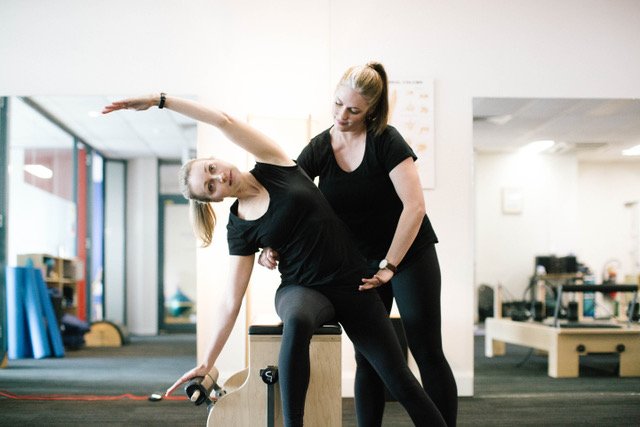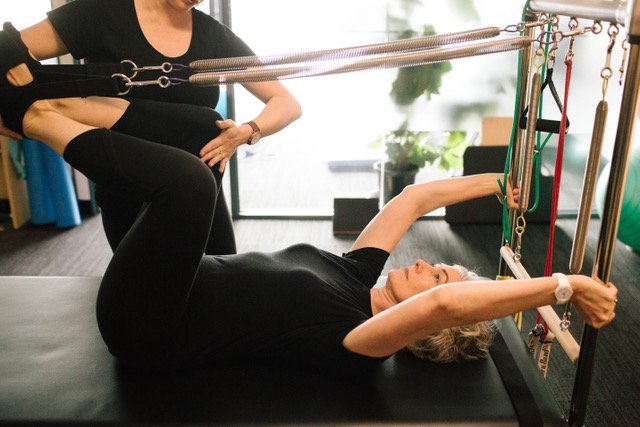Hips Don’t Lie
Hips are complex and fascinating joints. The more I work with people experiencing hip pain, the more literature I read about hips and the more I explore and experience different exercises on my own hips, the deeper my fascination grows. I’ve tried to identify some of the tips and tricks I’ve discovered along the way including some problem-solving strategies that you might find helpful when working with clients with tight, achy or sore hips.
My strategy involves a two-stage process which begins with releasing and subsequently strengthening the hips because in my experience, this gives the best results.
Releasing the hips
Most of my sessions start with an exercise to release the problem hip, especially with anyone remarking on tight hips, anterior hip pain, tightness or a grumbly low back. My preference is to use a small, firm round ball. I find these are very targeted, and give a smooth surface for the muscles to release around. I like a small ball for really getting into specific areas, and knowing your anatomy is super useful. Pull out those anatomy charts – and while you’re at it – educate your clients on the why of what you’re doing so they can give you feedback which will help you to determine not only the course of that session, but your programming overall.
I also use spikey balls, and I know people love them. I’d encourage you to try both, and do what suits you and your clients.
Spikey ball lateral glutes bilaterally – knee openings double and single with a license to rotate the pelvis from side to side.
Spikey balls into central glute bilaterally – add hip flexion single leg, up up down down and femur circles. Be mindful about them not falling into a posterior pelvic tilt.
Smooth ball into hip rotators – roll the pelvis down toward the sit bone on the side you’re trying to release.
Foam roller release of quads bilaterally/unilaterally and adductors and foam roller/ball release of tensor fasciae latae (TFL). I like to use this for desensitisation. I find it’s helpful to down-regulate these muscles when we are trying to work on strengthening specific muscles around the hip and pelvis.
I like to spend a minimum of ten minutes on this release series. Releasing (but not stretching!) the muscles before strengthening is something that is overlooked but is, in my opinion, essential to a good outcome. After each stage, I think it’s useful to record how you/the client feels, especially when you’re introducing this series. The art of noticing and becoming attuned to how your body feels is an undervalued skill (and one that takes time to develop).
I know that the activity is effective when the client reports feeling heavier and more grounded to the mat. I talk about the idea of spreading your glutes across the mat to make the biggest widest imprint possible. I use the analogy of instead of resting on two firm peaches, it should feel like melted ice cream!
This provides the perfect environment to work on specific strengthening and the concepts of active hip relaxation – rather than overusing the muscles surrounding the hip and pelvis and ending up with a gripping or clamping sensation. This is specifically important in relation to psoas and TFL. I encourage lightness, gliding and smooth glossy movements. These cues give a lovely smooth quality to hip movements and help with better muscle activation. Now we are primed and ready to work on some strength!
Strengthening the hips
There are so many exercises we could choose for strengthening the glutes, and each body will respond differently to the same exercises. I primarily like to look at
· Adductor strength
· Glute max strength
· Glute medius strength
· Hip external rotator and internal rotation strength and range of motion (ROM)
independently and then introduce more complex movements depending on where their deficiencies are.
Some of my all-time favourites include:
Adductor squeezes with a ball or magic circle squeeze. Be super mindful of using the proximal adductors and keep the front of the hips and glutes relaxed.
Wide Sides to Sides with knees: I love this to work to increase internal and external ROM of the hips. Move the knees like windscreen wipers and try to maximise the pivoting of the hip gliding within the hip capsule before you add rotation of the pelvis. A beautiful movement that really feels like it’s lubricating and nourishing the hip joint.
Low bridges; Keep it low! I teach this just hovering the hips off the floor. You can add a band around the knees to increase the work for the hip abductors. Or a ball between the knees to preference the adductors. You can also add a weight on the hips to increase to work holding the hips up off the floor. Make sure whatever variation you choose the foot is firmly planted to the floor especially the big toe joint if you add abduction.
Four point kneel rock backs: My solution to quad dominance in squats – try to hip hinge and activate the glutes in four point kneeling. Press the knees apart to isolate the abductors and slowly move the sit bones back maintaining neutral spine working glute max eccentrically. This is a great exercise to get the glutes working and if femoral head control and sacral nutation are a priority.
Assisted Squats: I teach these either hanging off the upright poles at the end of the trapeze table, with the tower bar, or the TRX suspension system. I find it useful to work squat patterning while managing how much load you put through the legs/pull with the arms. Great to try after the rock back exercise above. They work beautifully as a duo to give glute activation and awareness through a hip hinge. Talk the client through the femoral head gliding right back to nestle in the hip capsule, and how they can use the eccentric glute control that they mastered in the rock back to assist.
Standing leg press: My favourite exercise of all time! I love the balance challenge for the standing leg with a super light spring. Finding good organisation standing on a single leg is tricky. Optional extras (certainly not an exhaustive list) include adding rotation in the thoracic spine, calf rises on the supporting leg or a foam pad under the foot.
Scooter with preference into adduction/abduction with power band: An exercise that is a consistent addition to many Pilates classes. Moving away from the reformer and including the powerband gives an extra dimension of control, strength and stability into the exercise.
In all of these exercises education of your client is key! The more they understand the intention behind what they’re trying to do, and the muscle that should be working or not, the better the feedback they will be able to give you. Try to ask open-ended questions. Rather than saying ‘is that feeling good?’ Try asking ‘how does that feel?’ or ‘where are you feeling that?’
In closing, a few related tips and observations.
· Don’t be worried about making them sore – it’s likely to happen along the journey as you both figure out the best way to navigate getting stronger together. But at the same time, it’s something that’s important to talk to them about these issues.
· Progress isn’t linear, and there are lots of factors impacting their outcomes. Don’t worry about making an exercise look pretty or perfect. Be playful and experiment. You can always go back to a release or exercise that you did earlier, or in another session that left them feeling good.
· Don’t be fearful of making a mistake or the client ending up sore will either mean you will avoid the area completely or not challenge them sufficiently.
· Teach strategies for times when they’re away from the studio and feeling sore. This will empower them to manage their own bodies. As I always say to my clients, there’s no point in me holding my cards close to my chest and not showing you what and why I’m choosing specific exercises. I need you to problem-solve alongside me if we’re going to succeed together
· Don’t be afraid to fail! Or for the client to fail – sometimes we need to watch things unfold (so long as no risk is involved) rather than micro-manage. Don’t confuse problem-solving with micro-managing. In this respect, I’ve found a number of parallels between parenting and Pilates teaching!
This is where communication, confidence and experience all come into play. If you don’t have honest open communication with your client, you won’t be able to hear their perspective which is imperative to a successful outcome.
I really encourage you to be creative, critically problem solve and think about how you can use the movements and repertoire you know and tweak them to preference certain muscles. Our teaching, like us and our clients, needs to evolve. Be clear on your objectives, and use your flexibility and curiosity as your teaching superpower!
Julia is the owner and director of Evolved Pilates in Fairfield, Melbourne which she opened in 2014. Julia has been teaching for Pilates for 20 years, and her work alongside a range of health practitioners along with her dance experience earlier in life, ignited a lifelong love of the method and its intelligent movement principles.
Julia has a passion for Pilates education, having taught Pilates teachers and delivers regular lectures on a range of related topics to allied health practitioners, Pilates teachers and into the dance world. She will be presenting ‘It’s Hip to be Square’ at the 2023 PAA Conference in August in Australia.



